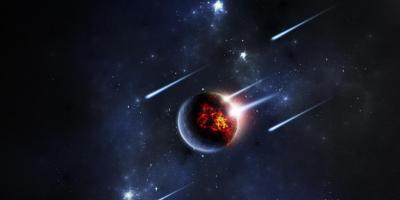As soon as we see a shooting star, we immediately make a wish. But do stars really fall? And what would happen if this happened? Is such a phenomenon possible in zero gravity conditions?
In fact, this is just a beautiful expression that does not reflect reality at all. In such cases, we see that it is caused by meteorite showers entering the atmosphere. Most often, the phenomenon can be observed during the period from August 12 to 14 annually in the northern latitudes of our country. The meteor shower is called the Perseid.
Why is this happening?
Do stars really fall? No, what we see in the sky are just meteoroids, asteroids and other meteoroids burning in the atmosphere. Meteoroids that did not collapse when entering the Earth’s atmosphere and flew to the surface are already called meteorites. Flight marks in the sky can be observed for several seconds or minutes.
Comets circle around the Sun, leaving behind a trail of fragments, which over time group and transform into meteor showers. When the Earth intersects with such flows, then a “starfall” appears.
What are stars?
Stars are balls of light and gas. The closest star to Earth is the Sun. Other space objects are far enough away that when we look into the sky we see small points of light. If we compare the sizes of the Earth and the Sun, then our planet is more like a speck of dust in relation to the Sun, which in diameter is 696.342 thousand kilometers (error - 65 kilometers). And the Earth is only 12,742 kilometers in diameter. Do stars really fall? It’s even hard to imagine what would happen if the Sun fell on the Earth - it would simply burn out in a matter of seconds.
Difference between cosmic bodies
Meteorites are solid bodies, it can be stone or ice or metal. As a rule, having reached the ground, these space objects are more like peas, but they can also be quite large. Usually they are visible in the sky from Earth.

Objects called asteroids are typically huge, rocky objects that arrive in the orbit of the Earth and Sun from the orbits of Jupiter or Mars.
Comets are blocks of ice that can contain ammonia, methane and other chemical compounds. Typically, such objects are surrounded by a “coma,” that is, a cloud-like shell. When a comet approaches the orbit of the Sun, it develops a “tail.”
Why does a trace remain?
Do stars fall to earth? As is already clear - no. But why do space objects glow brightly when falling? Everything is very simple: a space object is a meteorite, it doesn’t matter whether it’s metal or stone, and during its flight, flying through the atmosphere, it heats up to a high temperature. And this happens due to friction. By the way, for this reason, spaceships have a special casing so that the rocket itself and the people in it do not burn out. Those comets that are large enough may not completely burn up in the atmosphere and reach the Earth's surface.
The most famous cases of meteorite falls
Do stars fall from the sky? No. But meteorites fall. The most interesting cases of falling space objects:
- In 1908, a meteorite fell near the Podkamennaya River, which was later named Tunguska. However, numerous expeditions failed to discover the meteorite, only magnetite and silicate balls of microscopic size. Although the force of the explosion was more than 50 megatons. On an area of about 2 thousand square kilometers, huge trees were uprooted.

- In 1922, local residents observed the fall of a huge stone, after which a meteor shower began. The remains of space objects were found only 50 years later, with a diameter of 25 kilometers from the supposed site of the meteorite fall; these were 82 chondritic objects. The largest weighed 284 kilograms, and the smallest weighed 50 grams.
- In Namibia you can see the largest space object on Earth - the Goba meteorite. It is actually a block weighing 60 tons, consisting of nickel and iron with a small content of cobalt. But only dinosaurs could see such a unique phenomenon, who probably did not think about the question of whether stars are falling.
- In 1947, a meteor shower occurred in the Primorsky Territory of the Russian Federation (in the village of Beitsukhe), creating several craters over an area of about 35 square kilometers. The largest fragment weighs 23 tons.
- In 1696, a meteorite weighing 5 tons fell in Mexico (Chihuahua). Today it is the most studied space object on the entire planet. By the way, it contains a mineral that does not exist on the planet, and they called it pangite.

And on the Moon, even from Earth you can see traces of meteorite falls - these are the famous craters. Such craters also exist on our planet, but they are covered with ocean waters or volcanic ash, or have eroded over millions of years.
When can you watch stars fall?
It doesn’t matter whether stars fall to Earth or not, but sometimes you really want to make a wish. If we talk about single space objects, then it is impossible to predict their fall. And large flows can be predicted, especially since it has already been clearly established that such phenomena occur regularly.
The most regular annual shower of cosmic bodies is the Perseids. The phenomenon occurs in the month of August, approximately from the 12th to the 14th. It is associated with the approach of comet Swift-Tuttle. Although the celestial body approaches our planet only once every 135 years. However, the comet's dust plume is visible on Earth every year. Some particles enter the atmosphere.

Forecast for 2018
- In July, from the 28th to the 30th, you can see a whole stream of Aquarids, which can be observed near the constellation Aquarius.
- The Arietids starfall is one of the longest: from May 20 to July 2. However, the peak of activity occurs on June 7th and 8th. If you are wondering whether stars are falling, you will have to get up at sunrise and watch the phenomenon for 30 minutes.
- From October 8 to 10, residents of the Northern Hemisphere will be lucky - they will be able to observe the “star shower” called the Draconids. The phenomenon can be seen at night, with approximately 15 stars falling per hour.
- One of the most beautiful phenomena is predicted for the period from October 2 to November 7. The peak occurs on October 20-21. Quite large falling space objects with noticeable traces behind will be visible.
However, do not forget, in order to fully enjoy the amazing phenomenon of falling space objects, it is better to go outside the city limits, where high-rise buildings will not interfere, and the sky will be completely open to view.
We often hear about starfalls, and sometimes we ourselves manage to notice a bright object flying between the stars of the night sky, leaving behind a luminous tail. What is actually falling and why is this happening?
Naturally, the objects we observe are in no way falling stars. Even the closest star system to us (Alpha Centauri) moves across the sky almost imperceptibly to the human eye (no more than 1/60 of a degree). Therefore, starfalls that we can periodically observe in the sky are nothing more than small cosmic bodies flying near the Earth.
Meteora
The main contender for the role of a “shooting star” is. A meteor is a phenomenon that occurs as a result of the combustion of any small meteoroid bodies, such as fragments of asteroids or comets, in the Earth's atmosphere. This happens due to the friction of a fast-flying body against the surrounding layers of the atmosphere, consisting of nitrogen, oxygen and other gases. Bodies can either fall directly onto the Earth or fly past so close that they enter the Earth's atmosphere. In the second case, the body is able to fly out of the Earth's atmosphere and continue its journey, while losing part of its mass as a result of combustion. In the first case, if the body does not burn completely and reaches the surface of the Earth, then it will be called a meteorite. In both cases, we will observe the process of burning such a body in the atmosphere (meteor) - what is usually called a “shooting star”.

Meteor showers
It is noteworthy that meteors are observed that can be caused by the combustion not only of some passing single cosmic body, but also of entire swarms of such bodies. In this case they talk about "". During this phenomenon, the simultaneous combustion of several tens or even hundreds of cosmic bodies can be observed in the sky. It should be noted that the meteor swarm that forms a meteor shower consists of many small bodies flying in the same direction and generally moving in one specific orbit. Considering this fact, as well as the fact that these orbits often coincide with the orbits of previously existing or existing asteroids, scientists are inclined to believe that these cosmic bodies were formed as a result of the disintegration of the mentioned large bodies and are their fragments. The fragments, continuing to move in a certain orbit, can be seen by observers at a strictly defined time of year in a predetermined place in the sky.

The radiant is the region of the celestial sphere that appears to be the source of meteors.
The name of a meteor shower may come from the constellation in which it can be observed, or from the star against which it flies (for example,). To date, astronomers have confirmed the existence of more than 60 meteor showers and more than 300 hundred showers are awaiting confirmation.
If a meteor shower is a periodic phenomenon and, in principle, predictable, then a meteor shower is not a periodic phenomenon. The difference between a meteor shower and a meteor shower is that the first is caused not simply by bodies flying through the atmosphere, but by bodies falling on the surface of the Earth. Then a meteor shower caused by the same swarm of bodies cannot be observed twice, since as a result of it all the bodies either burn up in the atmosphere or fall to the surface of the Earth.
Comets
It is worth noting that a “shooting star” can arise not only as a result of friction of a cosmic body with the Earth’s atmosphere. We know that asteroids are solid bodies, usually made of metals and carbon or hard elements such as silicon. A comet usually consists of ice interspersed with some solid matter.
Since the comet revolves around the Sun, when approaching this heated body, it begins to partially melt. In this case, a cloud of gas and dust (coma) glows against the background of the sun’s rays, and behind it a tail of sublimated volatile substances, such as water, methane or nitrogen, forms around the comet. Let us recall that sublimation is the transition of a substance from a solid state directly to a gaseous state, bypassing the liquid state (evaporation is a transition from liquid to gaseous). The tail that arose due to sublimation, along with the coma, is illuminated by the Sun, as a result of which we can also observe a “shooting star” in the sky. It is noteworthy that the comet's tail is almost always directed away from the Sun, which makes it possible to determine the position of the Sun in the part of the sky hidden at night.

In addition to natural cosmic bodies, meteors can be caused by various types of space debris that orbit the Earth.
List of meteor showers
| Name | Stream dates | Peak flow | Speed km/s | ZHR | Intensity | Progenitor (comet or asteroid) |
|---|---|---|---|---|---|---|
| December 7 - December 17 | December 14 | 35 | 120 | Strong | 3200 Phaeton | |
| July, 12 - August 19 | July 28th | 41 | 20 | Weak | 96P/Machholz 1 | |
Meteorite
Have you ever seen a shooting star create a fiery trail in the night sky? The impression is as if one of the stars fell from the sky and fell to Earth. In fact, it is not a star, but a meteorite. From afar, you can indeed confuse a star with a meteorite, but in reality they are completely different things.
Difference between stars, meteorites and asteroids
The stars are huge glowing spherical accumulations of hot gas that look small only because they are very far from us. Our Sun is a medium-sized star, but it can hold a million planets like Earth.
Meteorites the ones that burn so brightly in the sky are solid bodies. These are usually pieces of rock, metal or ice that have broken off from comets or asteroids. Often these fragments are no larger than a pea in size. Like pieces of clay scattered around a finished sculpture.
Asteroids are large rock fragments formed during the formation of planets from a cloud of gas and dust. A large cluster of asteroids orbits the Sun in the space between Mars and Jupiter.
How are meteorites made?
When asteroids collide, and they happen over billions of years, their fragments fly in different directions. These fragments, called meteorites, travel very long distances because in the emptiness of interplanetary space there is no frictional force that could slow down their flight. Meteorite sizes range from a grain of sand to a boulder and larger. Dark and invisible, they rush in the eternal cold and darkness of space. When meteorites fly near the Earth, the force of gravity begins to act on them. This is how some meteorites enter the earth's atmosphere, flying into it at a speed of 30 to 200 thousand kilometers per hour.
Related materials:
Why do stars twinkle?
Bright trail when falling to Earth
Typically, rock and metal meteorites are captured by gravity and fall to Earth through the atmosphere. In this case, stone and metal fragments are heated to a very high temperature. The reason for this heating is friction. Try to rub your hand on the carpet, you will feel warmth - this is also the result of friction. On spacecraft, a special layer of skin protects the crew and ship from the thermal effects of friction.
Meteorites do not have such casing and there is no one to protect them. Therefore, small meteorites simply burn up in the atmosphere from high temperatures. They flash in the sky and burn like candles, leaving behind only ashes. Large meteorites can survive the journey through the atmosphere, and then a rock falls on the Earth.
We've all made wishes more than once when we saw shooting stars. But have you ever thought about where they fall? What will happen to the constellations if one of the stars falls? And what makes stars fall if there is weightlessness in space?
What are the stars
To begin with, it is worth deciding what we mean by stars. In simple terms, stars are massive glowing balls of gas. The closest star to us is the Sun. All other objects of this kind are significantly removed from our planet, which is why they appear in the sky not as huge luminaries, but only as small white dots.
Why do stars fall
Let's start with the most important thing, namely that stars don't fall at all. Objects falling from the sky are not stars at all and are just burning up in the atmosphere meteoroids(remains of comets and asteroids). The process of burning a meteoroid is called meteor, while meteoroids that do not burn up in the atmosphere and reach the Earth’s surface are called meteorites. The meteor trail usually disappears in a matter of seconds, but can sometimes remain for as long as minutes and even be moved by the wind.
As we have already said, meteoroids are most often the remnants of comets. As you know, comets circle the Sun and leave a trail of fragments along the entire length of their orbit. These fragments group together and form meteor showers. When crossing the Earth with such a flow, we see a “starfall”.


Intersection of the Earth's orbit with the orbit of a comet
When can you watch stars fall?
The fall of single meteoroids is a completely common occurrence, which is almost impossible to predict. But we are quite capable of predicting the intersection of the Earth with a large meteor shower, especially since this event repeats itself from year to year. Below we offer you a schedule of the largest star falls.
We strongly recommend that you take a closer look at the Perseids and Geminids. The frequency of “falling stars” when crossing these meteor showers can be several hundred per hour, and in terms of the number of especially bright “falling stars” no other meteor shower can compare with them.
Some of you do not know the old superstition. On a clear night, a bright star rolls down from the dark sky, which means “someone has died.” This superstition arose at a time when people did not yet have any clear idea of the sky. It was believed that the sky was a solid blue vault resting on the Earth. And to this solid sky are attached a kind of small lamps - stars. Each person supposedly has his own star in the sky; it lights up with his birth and “falls” with his death.
The days of such ignorant ideas about the sky and stars are over. We now know that every star is a huge celestial body, often many times larger than our Sun. And it is absurd to think that along with the birth of people on Earth, huge celestial bodies appear in the universe. Of course, there is no connection between human life and the stars.
In reality, “falling stars do not exist either. And in fact, every evening we watch how tens and hundreds of “stars” “fall” from the sky, and at the same time all the constellations in the sky remain unchanged. What is the matter here? And the fact is that the so-called "falling stars" have no connection with real stars. These are just small grains of matter, barely flying into the atmosphere from outer space. The scientific name for "falling stars" is meteors.
Science has now established that in the global interstellar space many small solid particles are rushing in different directions - small stones and blocks, large and small dust particles. Often these particles meet the Earth and fly into our atmosphere at tremendous speed (tens of kilometers per second). At an altitude of 150-120 kilometers above the Earth's surface, the meteoroid body begins to experience air resistance; a kind of compressed air “cushion” forms in front of it. Meteor particles of matter become very hot and turn into gases, on average already at an altitude of 130-60 kilometers above the earth's surface.
The particles of matter that give rise to meteors mostly weigh fractions of a gram.
At times in the sky you can observe not individual “falling stars”, but a whole “rain of stars” (Fig. 24). Of course, there is no miracle here either. This celestial phenomenon is observed when the Earth meets on its path not with individual meteoric particles, but with entire swarms of these small particles. They are often the remains of previous comets. Every moment during this time, dozens of fiery meteors are observed. A memorable spectacle for a long time!
Such a large “star shower” was observed, for example, in October 1933, as well as in October 1946.
Meteor showers also occur, as we have already said, when the Earth collides with a comet nucleus. For this reason, the “rain” was especially bright in 1885, during a new meeting of the Earth with the remnants of Comet Biela.
|
Rice. 24. Star rain (ancient drawing). |
In past centuries, superstitious people associated the phenomenon of “star showers” with events on earth and considered them a harbinger of bad things. Not knowing the reasons for this unusual phenomenon, not knowing how to explain it, people believed “once again” absurd inventions.
Now we know not only the cause of this phenomenon, but we can also predict the time of occurrence of meteor showers.
"rains" in the future. It is known that every year the Earth encounters the same clusters of meteoroids on its way around the Sun in certain months. For example, every year on August 9-14, the Earth encounters a swarm of meteor particles. On these days, weak “star showers” are observed annually.
At the same time, it seems to us from the Earth that a stream of meteorosis flies out, as it were, from the constellation Perseus. That's why the annual August meteors are called Perseids. The Perseids have been observed for over 1000 years!
There are meteor showers that produce abundant “star showers” only once every few decades. This is the stream of meteors emerging from the constellation Leo - Leonids (from the word leo - lion). The Leonids give abundant “star showers” once every 33 years. Previously, the Leonid fallout was described by historians and chroniclers as outlandish “heavenly visions.” In China they were noted more than 3,700 years ago.
Brilliant “star showers” are sometimes produced by April meteors (April 19-22), emerging from the Lyra-Lyrid constellation. The last such “rain” of the Lyrid was in April 1952.








